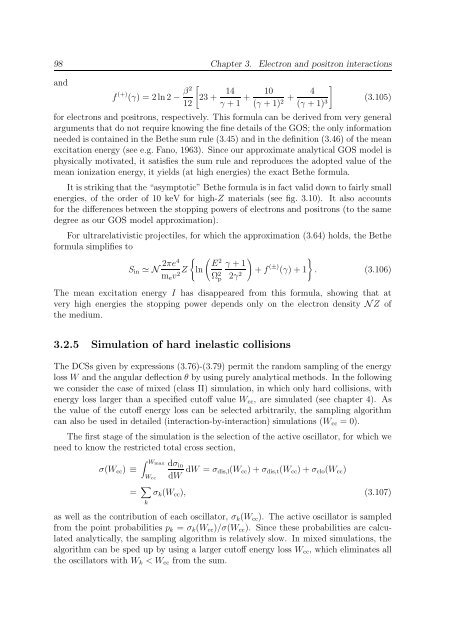PENELOPE 2003 - OECD Nuclear Energy Agency
PENELOPE 2003 - OECD Nuclear Energy Agency
PENELOPE 2003 - OECD Nuclear Energy Agency
You also want an ePaper? Increase the reach of your titles
YUMPU automatically turns print PDFs into web optimized ePapers that Google loves.
98 Chapter 3. Electron and positron interactions<br />
and<br />
[<br />
f (+) (γ) = 2 ln 2 − β2<br />
23 + 14<br />
]<br />
12 γ + 1 + 10<br />
(γ + 1) + 4<br />
2 (γ + 1) 3<br />
(3.105)<br />
for electrons and positrons, respectively. This formula can be derived from very general<br />
arguments that do not require knowing the fine details of the GOS; the only information<br />
needed is contained in the Bethe sum rule (3.45) and in the definition (3.46) of the mean<br />
excitation energy (see e.g. Fano, 1963). Since our approximate analytical GOS model is<br />
physically motivated, it satisfies the sum rule and reproduces the adopted value of the<br />
mean ionization energy, it yields (at high energies) the exact Bethe formula.<br />
It is striking that the “asymptotic” Bethe formula is in fact valid down to fairly small<br />
energies, of the order of 10 keV for high-Z materials (see fig. 3.10). It also accounts<br />
for the differences between the stopping powers of electrons and positrons (to the same<br />
degree as our GOS model approximation).<br />
For ultrarelativistic projectiles, for which the approximation (3.64) holds, the Bethe<br />
formula simplifies to<br />
{ ( )<br />
}<br />
S in ≃ N 2πe4 E<br />
2<br />
γ + 1<br />
m e v 2Z ln<br />
+ f (±) (γ) + 1 . (3.106)<br />
2γ 2<br />
Ω 2 p<br />
The mean excitation energy I has disappeared from this formula, showing that at<br />
very high energies the stopping power depends only on the electron density N Z of<br />
the medium.<br />
3.2.5 Simulation of hard inelastic collisions<br />
The DCSs given by expressions (3.76)-(3.79) permit the random sampling of the energy<br />
loss W and the angular deflection θ by using purely analytical methods. In the following<br />
we consider the case of mixed (class II) simulation, in which only hard collisions, with<br />
energy loss larger than a specified cutoff value W cc , are simulated (see chapter 4). As<br />
the value of the cutoff energy loss can be selected arbitrarily, the sampling algorithm<br />
can also be used in detailed (interaction-by-interaction) simulations (W cc = 0).<br />
The first stage of the simulation is the selection of the active oscillator, for which we<br />
need to know the restricted total cross section,<br />
σ(W cc ) ≡<br />
= ∑ k<br />
∫ Wmax<br />
W cc<br />
dσ in<br />
dW dW = σ dis,l(W cc ) + σ dis,t (W cc ) + σ clo (W cc )<br />
σ k (W cc ), (3.107)<br />
as well as the contribution of each oscillator, σ k (W cc ). The active oscillator is sampled<br />
from the point probabilities p k = σ k (W cc )/σ(W cc ). Since these probabilities are calculated<br />
analytically, the sampling algorithm is relatively slow. In mixed simulations, the<br />
algorithm can be sped up by using a larger cutoff energy loss W cc , which eliminates all<br />
the oscillators with W k < W cc from the sum.
















